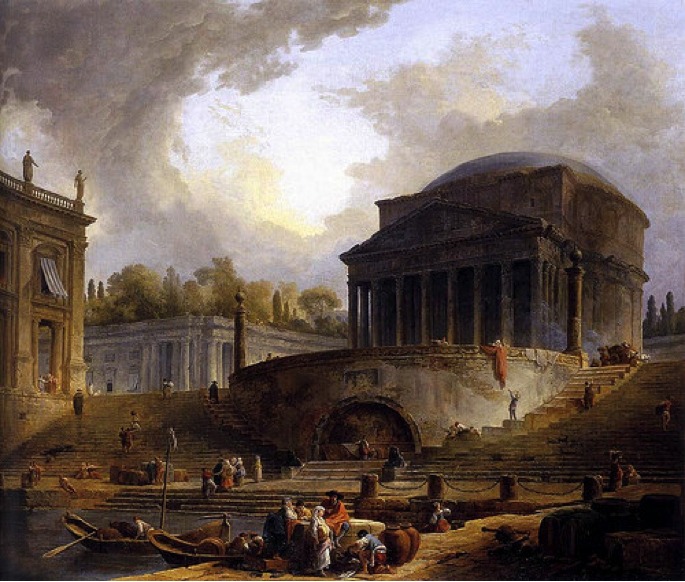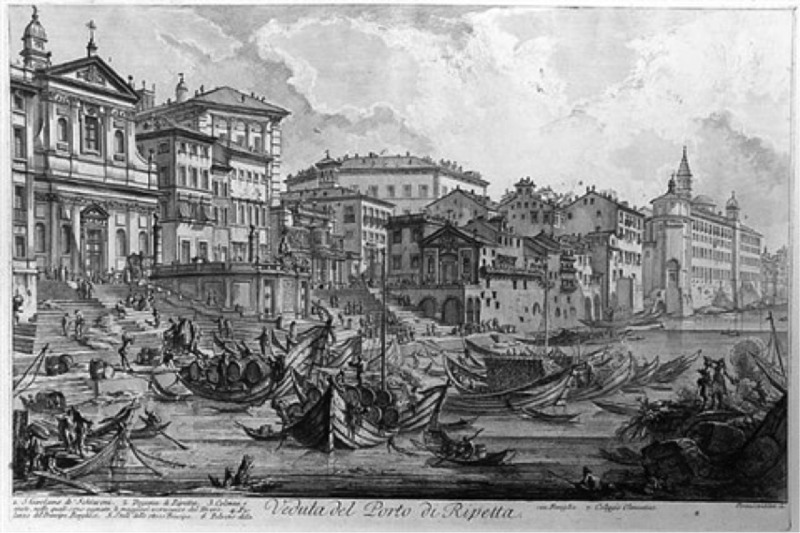Return to Paris

Hubert Robert, Port of Ripetta, Rome, 1766-1767, oil on canvas (École Nationale Supérieure des Beaux-Arts, Paris, France)

Giovanni Battista Piranesi, "Veduta del Porto di Ripetta" from Vedute di Roma, ca. 1753, etching (Metropolitan Museum of Art, New York, New York)
Robert returned in Paris in July of 1765 when he was about thirty-two years old. Just a year after his return, Robert was given full membership and into the Académie Royale de Peintre et de Sculpture and was also appointed to associate level in the same session–an impressive achievement. Usually this occurred in two separate steps and took artists several years to attain, but Robert’s admission piece, a capriccio titled Port of Ripetta, Rome, was so well received that it allowed him to skip the long process. The painting’s fictive composition features the Pantheon, removed from its original location and placed in the center of Rome, near the Tiber River, at the (now destroyed) Port of Ripetta. It exhibits a warm palette much like those of Panini’s paintings, as well as an angled perspective reminiscent of Piranesi’s etchings.1 Piranesi also created a version of the scene – Veduta del Porto di Ripetta (1751) which, unsurprisingly, shares very few visual similarities with Robert’s capriccio. If Piranesi’s version offers a more accurate depiction of what the port actually looked like, it is clear that Robert’s version works to emphasize the artist’s imaginative eye. That his painting was received so well at the Académie indicates how acceptable it was at the time to repurpose and relocate ancient monuments in one’s artwork.
Along with Port of Ripetta, Rome Robert debuted twelve of his other works in the Salon of 1767. This included three other views of ruins, four landscapes, three compositions of real or imaginary architecture, and two picturesque objects.2 Robert also exhibited a large decorative canvas of an Italianate landscape during his debut.3 He continued to present his works in the Salons until 1798.
Following his early success in the Académie, Robert continued to develop his signature style of incorporating Roman ruins into imaginative French and Italian landscapes, and gradually began to paint on larger and more monumental canvases as well. His powerful connections served him well as he was able to maintain a comfortable living, residing in royal lodgings from 1771 to 1778 and receiving commissions from the King and from wealthy French aristocrats. He was also quite popular among Russian patrons such as Count Alexander Stroganov (1733-1811), President of the Russian Academy of Arts, the Yusupovs, a noble family known for its immense wealth, and even Catherine II (1729-1796), Empress of Russia.4
After 1778 and until 1802, Robert lived in the Louvre, then a royal palace, to assist in the plan to convert its Grande Galerie into a museum to display the royal collection to the public. The creation of a public gallery had originally been proposed by the art critic Étienne La Font de Saint-Yenne (1688-1771) in 1747, though the museum would not be realized until the French Revolution. From 1778 to 1788 Robert also designed gardens and interiors for his patrons. He remained in Paris until his death in 1808. By that time, Robert had lived through several key moments in French history: the end of the monarchy, the French Revolution, and the beginning of the Napoleonic regime.
SYL
_____________________________________________________________________________________
1Margaret Grasselli and Yuriko Jackall, Hubert Robert (Washington, D.C: National Gallery of Art, 2016), 225.
2Grasselli, Hubert Robert, 61.
3Ibid.
4Catherine Voiriot, “A Driven Yet Most Amiable Man,” in Hubert Robert, ed. Michelle Piranio (Washington, D.C: National Gallery of Art, 2016), 53.